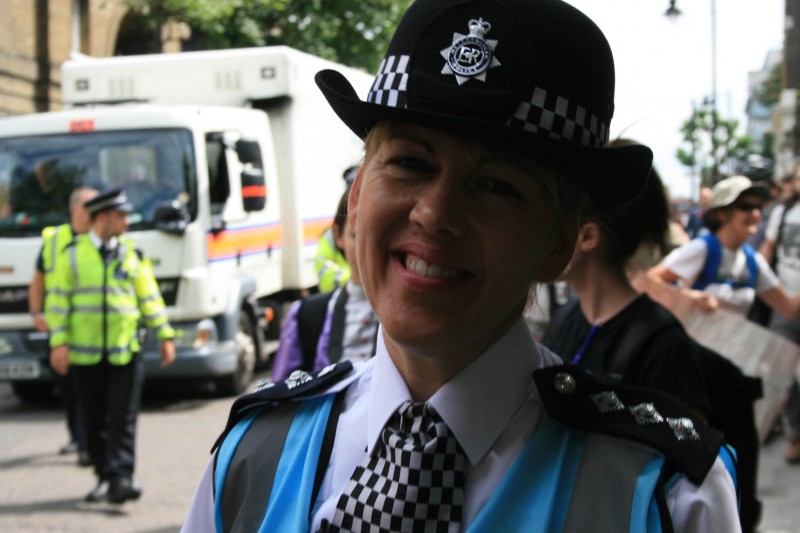The Intelligence Gathering Role of Police Liaison Officers
We all know Police Liaison Officers (PLOs): their baby blue bibs, their smiling faces, their fondness for photo opportunities and good PR. We know their Twitter accounts, and their public guise as the new friendly face of public order policing.
Police Liaison Officers (PLOs) have become a regular part of the policing of political protest up and down the country, ostensibly to promote ‘dialogue and communication’.
PLOs are of immense value as an intelligence gathering tool. Rather than stay on the peripheries of a demonstration, as other police units do, they embed themselves within it. Working in ones and twos they move amongst the crowd, chatting, watching, and building relationships with protesters. It is surely highly unlikely that this capacity for intelligence gathering would not be exploited.
Sussex police insist that the ‘primary role’ of PLOs is not data gathering, but “to increase engagement with protest groups by supporting an open and honest two-way dialogue with them, before during and after events.” They have so far been less forthcoming in describing what happens to any information gathered by PLOs in the course of this dialogue, or whether that information is retained on police databases or made available to other policing bodies.
When questioned in court, Chief Inspector Sonia Davies (pictured above), stated that “obviously, we want to gather information, but that’s different to intelligence.” “Intelligence”, according to Davis, was narrowly defined as “information that has come from police sources and is acted upon”. “Information” was anything else. This might include the demographic or the mood of the crowd, or personal data about individuals present. She said that unlike Forward Intelligence Team (FIT) officers, PLOs are not shown photographs of known individuals at their briefings, but that FIT officers would helpfully identify any trouble makers for them, and alert them when a ‘person of interest’ was present or approaching.
Davis said that PLOs, picked for their “communication skills”, try to establish a rapport with individuals in the crowd: part of the PLO function, she went on to say, was to “find out who can help us establish self-policing within a crowd.” So when the PLOs approach people on a protest, it is often to identify those who would be willing to work more closely with the police.
Remarkably, Davis also confirmed that PLOs were deployed covertly. Davis explained that at least six Police Liaison Officers attended a Critical Mass in London in plain clothes, with four officers on pushbikes, and others on foot or in a vehicle. Clearly, in this instance at least, PLOs were used not to engage in open dialogue, or to facilitate, but to secretly spy on regular Critical Mass cyclists.
Both Sussex and Metropolitan Police forces have recruited PLOs with a background in intelligence. In Sussex, PLO Sean McDonald was well known by activists in Brighton for his previous role in forward intelligence and public order policing. The Metropolitan police have also deployed PLOs with an intelligence or counter-terrorism background.
Few object to courteous, friendly and helpful policing. But this police initiative is dishonest and manipulative. Far from actively facilitating protest, it forms part of a wider policing strategy that focuses on deterring and preventing it.
***** The full articles can be found on the Network For Police Monitoring website here and here. Jason Parkinson, in a film made for the Guardian, has questioned the extent to which the PLOs are also using their role to intimidate, harass, and gather intelligence on political activists.
